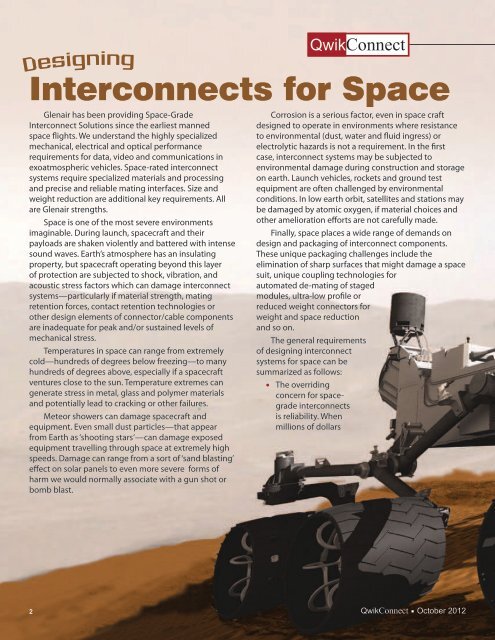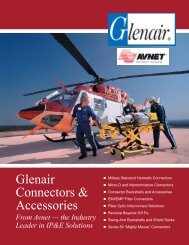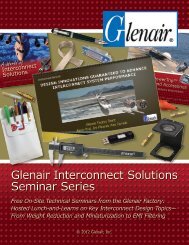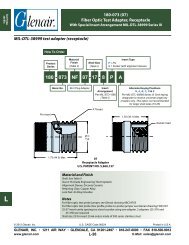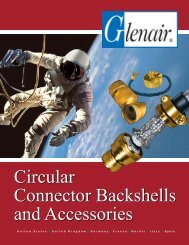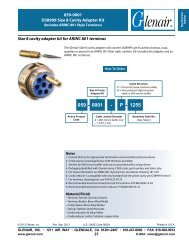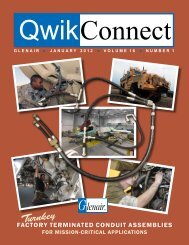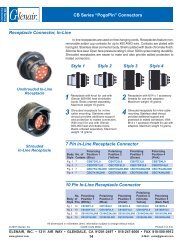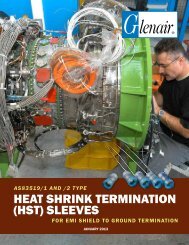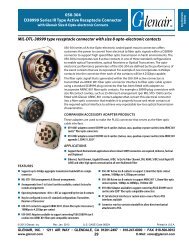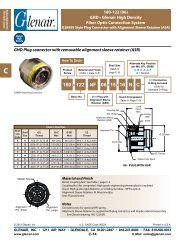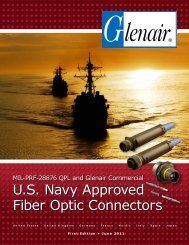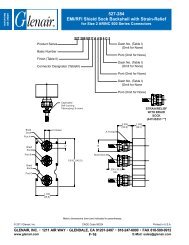Two page spread - Glenair, Inc.
Two page spread - Glenair, Inc.
Two page spread - Glenair, Inc.
You also want an ePaper? Increase the reach of your titles
YUMPU automatically turns print PDFs into web optimized ePapers that Google loves.
Designing<br />
<strong>Glenair</strong> has been providing Space-Grade<br />
Interconnect Solutions since the earliest manned<br />
space flights. We understand the highly specialized<br />
mechanical, electrical and optical performance<br />
requirements for data, video and communications in<br />
exoatmospheric vehicles. Space-rated interconnect<br />
systems require specialized materials and processing<br />
and precise and reliable mating interfaces. Size and<br />
weight reduction are additional key requirements. All<br />
are <strong>Glenair</strong> strengths.<br />
Space is one of the most severe environments<br />
imaginable. During launch, spacecraft and their<br />
payloads are shaken violently and battered with intense<br />
sound waves. Earth’s atmosphere has an insulating<br />
property, but spacecraft operating beyond this layer<br />
of protection are subjected to shock, vibration, and<br />
acoustic stress factors which can damage interconnect<br />
systems—particularly if material strength, mating<br />
retention forces, contact retention technologies or<br />
other design elements of connector/cable components<br />
are inadequate for peak and/or sustained levels of<br />
mechanical stress.<br />
Temperatures in space can range from extremely<br />
cold—hundreds of degrees below freezing—to many<br />
hundreds of degrees above, especially if a spacecraft<br />
ventures close to the sun. Temperature extremes can<br />
generate stress in metal, glass and polymer materials<br />
and potentially lead to cracking or other failures.<br />
Meteor showers can damage spacecraft and<br />
equipment. Even small dust particles—that appear<br />
from Earth as ‘shooting stars‘—can damage exposed<br />
equipment travelling through space at extremely high<br />
speeds. Damage can range from a sort of ‘sand blasting’<br />
effect on solar panels to even more severe forms of<br />
harm we would normally associate with a gun shot or<br />
bomb blast.<br />
QwikConnect<br />
Interconnects for Space<br />
Corrosion is a serious factor, even in space craft<br />
designed to operate in environments where resistance<br />
to environmental (dust, water and fluid ingress) or<br />
electrolytic hazards is not a requirement. In the first<br />
case, interconnect systems may be subjected to<br />
environmental damage during construction and storage<br />
on earth. Launch vehicles, rockets and ground test<br />
equipment are often challenged by environmental<br />
conditions. In low earth orbit, satellites and stations may<br />
be damaged by atomic oxygen, if material choices and<br />
other amelioration efforts are not carefully made.<br />
Finally, space places a wide range of demands on<br />
design and packaging of interconnect components.<br />
These unique packaging challenges include the<br />
elimination of sharp surfaces that might damage a space<br />
suit, unique coupling technologies for<br />
automated de-mating of staged<br />
modules, ultra-low profile or<br />
reduced weight connectors for<br />
weight and space reduction<br />
and so on.<br />
The general requirements<br />
of designing interconnect<br />
systems for space can be<br />
summarized as follows:<br />
• The overriding<br />
concern for spacegrade<br />
interconnects<br />
is reliability. When<br />
millions of dollars<br />
worth of equipment is at stake—not to mention<br />
invaluable human cargo when brave and talented<br />
women and men take flight—interconnect<br />
components have to work with assured reliability<br />
and safety every time.<br />
• Minimizing weight<br />
and package size<br />
of components,<br />
while maintaining<br />
strength and<br />
durability for spacegrade<br />
operation.<br />
• Systematic<br />
processing and<br />
screening of nonmetallic<br />
materials<br />
to prevent the<br />
outgassing of<br />
condensable<br />
material.<br />
• Utilization of materials and platings that withstand<br />
atomic oxygen corrosion in the space environment.<br />
• Building systems able to withstand the extreme hot<br />
and cold temperatures experienced in space.<br />
• Avoiding use of materials with undesirable<br />
ferromagnetic properties that could interfere with<br />
sensitive instruments on spacecraft.<br />
• Adhering to prohibitions on certain materials<br />
and finishes deemed unsafe for space-grade<br />
applications.<br />
• Qualifying to standards set forth by NASA, the<br />
European Space Agency, and other agencies<br />
governing space flight applications.<br />
We’ll cover these requirements and more in this<br />
special Space edition of QwikConnect.<br />
Dozens of robotic spacecraft, including orbiters, landers, and<br />
rovers, have been launched to Mars since the 1960s. <strong>Glenair</strong><br />
cables have ridden along on several, including the recent<br />
Curiosity rover program, helping to fulfill navigation, data and<br />
communication requirements.<br />
2<br />
QwikConnect • October 2012<br />
QwikConnect • October 2012<br />
3


